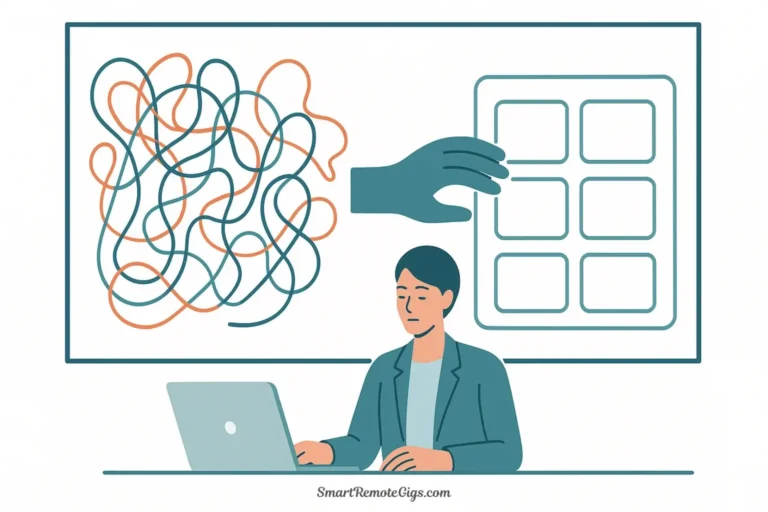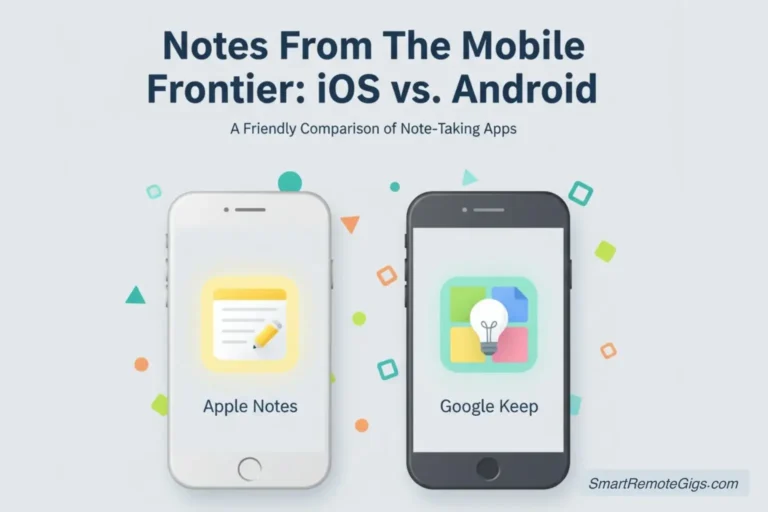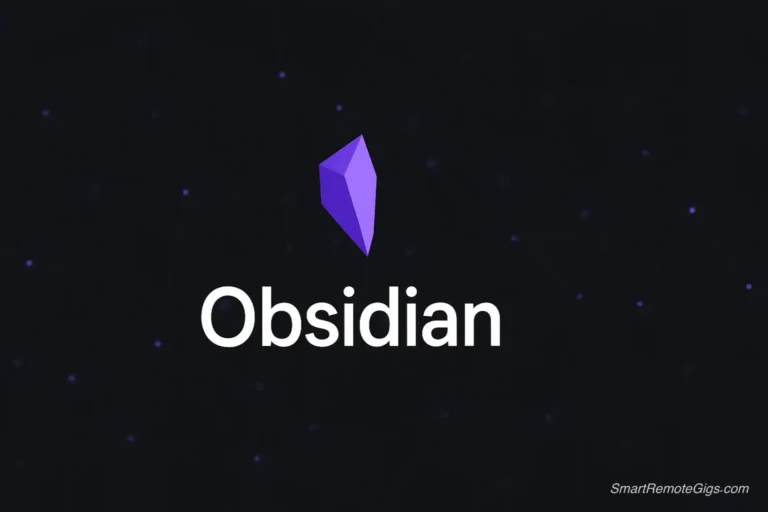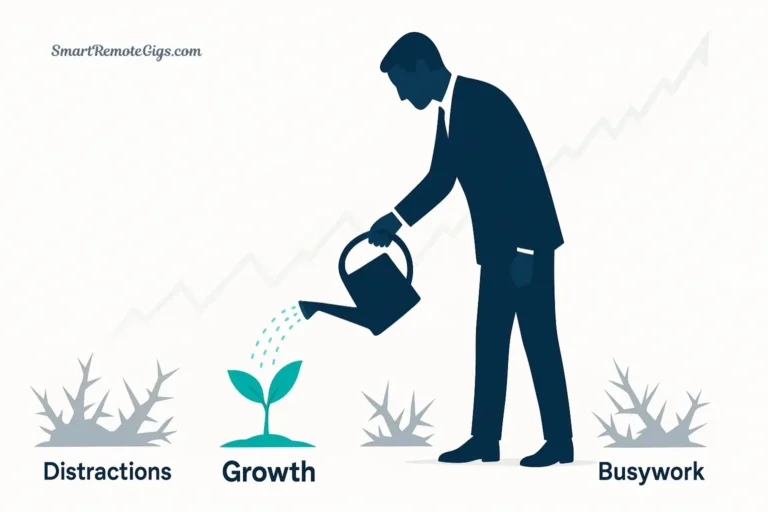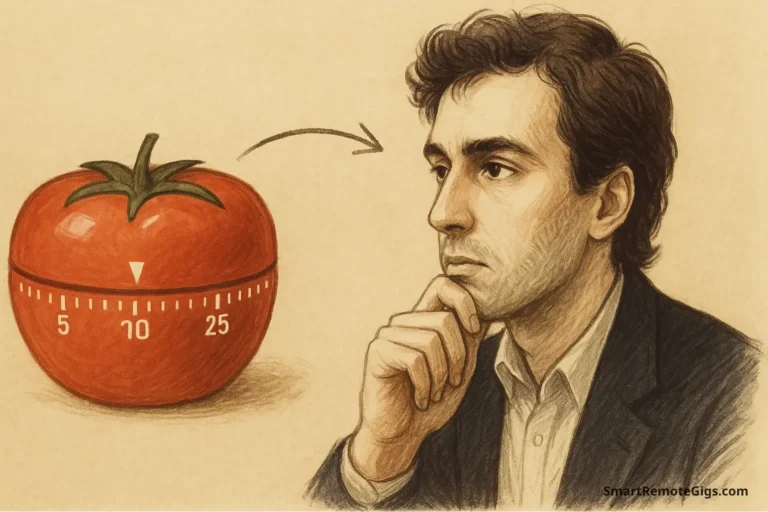You’re ready to get organized. You’ve read the blog posts, watched the videos, and you know you need a system. But you’re stuck between two giants: the elegant simplicity of the Eisenhower Matrix and the comprehensive structure of Getting Things Done (GTD).
One promises to cut through the noise and help you focus on what truly matters. The other offers a complete workflow system that ensures nothing falls through the cracks. Both have passionate advocates. Both deliver results. So which one is right for you?
This guide will give you a clear, honest comparison of both methodologies—their core philosophies, strengths, weaknesses, and ideal use cases. By the end, you’ll know exactly which system matches your work style, or whether the real answer is using both together.
The Core Philosophy: A Quick Breakdown
Before comparing features, it’s crucial to understand that these systems solve fundamentally different problems. They’re not just two approaches to the same thing—they’re designed for different aspects of productivity.
Eisenhower Matrix: A Framework for Prioritization
The Eisenhower Matrix is a decision-making framework that helps you determine what deserves your attention. It categorizes tasks into four quadrants based on urgency and importance, giving you a visual way to distinguish between:
- Quadrant 1: Urgent and important (Do immediately)
- Quadrant 2: Important but not urgent (Schedule proactively)
- Quadrant 3: Urgent but not important (Delegate)
- Quadrant 4: Neither urgent nor important (Eliminate)
The Purpose: To make strategic, high-level decisions about where to invest your finite time and energy. It answers the question: “What should I focus on?”
The matrix is lightweight, visual, and can be implemented in minutes. It’s a prioritization lens you can apply to any situation, from daily task lists to long-term strategic planning. Learn everything about how it works in our Ultimate Guide to the Eisenhower Matrix.
Getting Things Done (GTD): A System for Workflow Management
Getting Things Done, created by David Allen, is a comprehensive workflow management system. It’s not just about prioritization—it’s about capturing, clarifying, organizing, and reviewing 100% of your commitments so nothing lives in your head.
The Five Core Steps:
- Capture: Collect everything that has your attention
- Clarify: Process what each item means and what action it requires
- Organize: Put items in appropriate categories and lists
- Reflect: Review your system regularly to stay current
- Engage: Use your system to decide what to do in any moment
The Purpose: To create a trusted external system that frees your mind from holding information, allowing you to focus on execution. It answers the question: “How do I manage everything I need to do?”
GTD requires significant upfront investment—learning the methodology, setting up lists and contexts, and building the weekly review habit. For those who commit, it provides a level of control and peace of mind no other system can match. Learn the complete methodology in our Getting Things Done (GTD): A Beginner’s Guide for 2025.
Head-to-Head Comparison: Matrix vs. GTD at a Glance
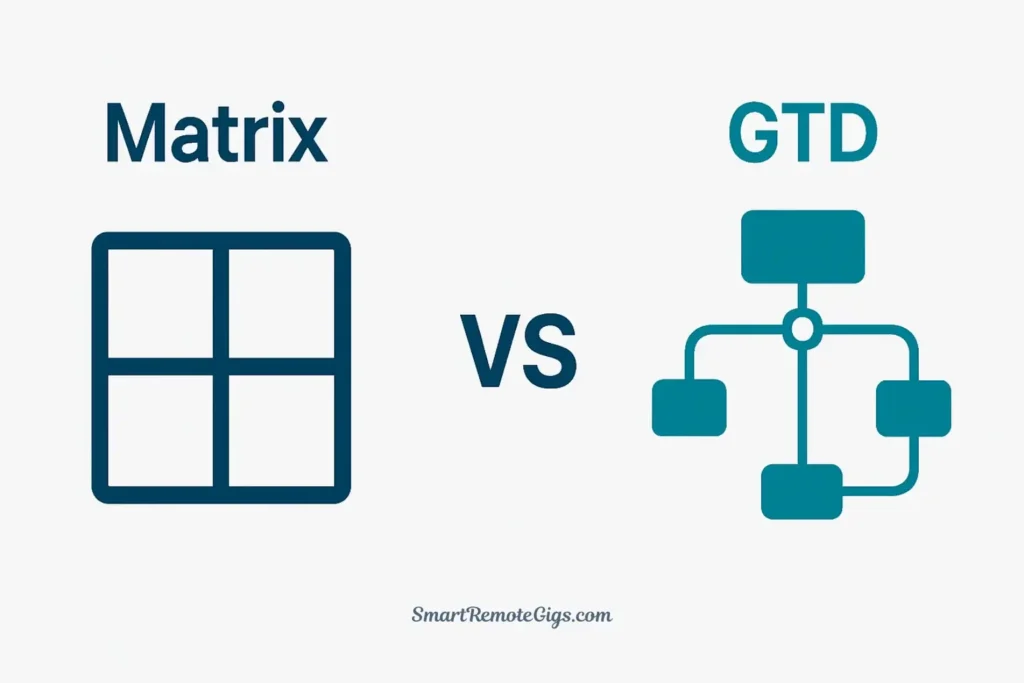
Aspect | Eisenhower Matrix | Getting Things Done (GTD) |
|---|---|---|
Core Idea | Prioritization framework based on urgency vs. importance | Complete workflow system for capturing and managing all commitments |
Best For | Leaders, managers, and anyone feeling overwhelmed by competing priorities | Knowledge workers juggling multiple projects with many moving parts |
Setup Time | 5-10 minutes (draw a grid, categorize tasks) | Several hours to days (read the book, set up lists, contexts, and workflows) |
Maintenance | Weekly review (20-30 minutes) | Weekly review (1-2 hours) plus daily capture and processing |
Mental Overhead | Low—simple two-dimensional framework | Moderate to High—requires understanding contexts, next actions, and multiple lists |
Main Strength | Clarity on what matters most; forces strategic thinking | Nothing falls through the cracks; complete mind-like-water state |
Main Weakness | Doesn’t help manage project details or track next actions | Can feel overwhelming; high commitment to maintain the system |
Flexibility | Easy to adapt to any tool (paper, spreadsheet, app) | Works best with GTD-specific tools or significant customization |
When to Choose the Eisenhower Matrix (Pros & Cons)
The Eisenhower Matrix shines in specific situations and for certain personality types. Here’s when it’s the right choice and when it falls short.
Choose the Eisenhower Matrix If…
You’re a leader, manager, or executive. The higher you go in an organization, the more your job becomes about making decisions rather than executing tasks. The matrix helps you distinguish between urgent interruptions (Quadrant 3) and strategic work that builds long-term value (Quadrant 2). If you’re constantly triaging stakeholder requests and protecting your team’s focus, this framework gives you a shared language to explain your decisions.
See our guides on the Eisenhower Matrix for project managers and Eisenhower Matrix for founders for role-specific applications.
You feel overwhelmed and need clarity immediately. When you’re drowning in tasks and don’t know where to start, the matrix cuts through the noise in minutes. You don’t need to read a 300-page book or set up a complex system—just list your tasks, categorize them into four quadrants, and act accordingly. The simplicity is the feature.
Your biggest problem is saying yes to too many things. If you struggle with boundaries, people-pleasing, or distinguishing between urgent and important, the matrix provides an objective framework for saying no. When someone brings you an “urgent” request, you can evaluate it against your strategic priorities and respond accordingly.
You want a thinking tool, not a task management system. The matrix is more philosophy than software. It teaches you to think differently about priority, which you can then apply to any existing tool or workflow you’re already using.
The Downsides: When the Matrix Falls Short
It doesn’t manage project complexity. The matrix tells you that “develop product roadmap” belongs in Quadrant 2, but it doesn’t help you break that down into actionable steps, track dependencies, or remember all the sub-tasks involved. If your work involves managing multiple complex projects with dozens of moving parts, you’ll need more than the matrix.
It requires discipline to revisit regularly. The matrix is only valuable if you use it consistently. Without a built-in review system, it’s easy to categorize tasks once and then revert to reacting to whatever screams loudest.
It can be subjective. What’s “important” to you might not be objectively clear, and urgency can be artificially created by external pressure. The matrix requires honest self-assessment, which some people find challenging without additional structure.
When to Choose GTD (Pros & Cons)
GTD is a different beast entirely—a comprehensive system that promises peace of mind if you’re willing to invest in building and maintaining it.
Choose Getting Things Done If…
You juggle multiple projects with many small tasks. If your work involves tracking dozens or hundreds of action items across different contexts (emails to send, calls to make, errands to run, things to discuss with specific people), GTD’s organizational system ensures nothing gets lost. The “next action” concept and context-based lists make it easy to see what you can do right now given your current situation.
You worry about things falling through the cracks. GTD’s power is in its completeness. When properly implemented, your system holds everything—every commitment, every project, every “someday/maybe” idea. This external brain gives you confidence that nothing will be forgotten, allowing your actual brain to focus on thinking and creating rather than remembering.
You’re willing to invest time upfront and maintain the system. GTD isn’t a quick fix. It requires reading the methodology, setting up your lists and contexts, and committing to a rigorous weekly review process. But for those who stick with it, the payoff is significant—a sense of control and clarity that compounds over time.
You resonate with the philosophy of “mind like water.” GTD isn’t just about productivity; it’s about achieving a stress-free state where you trust your system completely. If the idea of getting everything out of your head and into a trusted external system appeals to you philosophically, GTD might be your answer.
The Downsides: When GTD Feels Like Too Much
The learning curve is steep. Understanding the difference between projects, next actions, contexts, waiting-for lists, and someday/maybe lists takes time. Many people start GTD, get overwhelmed by the complexity, and abandon it within weeks.
It requires constant maintenance. GTD only works if you’re diligent about daily capture, weekly reviews, and processing your inbox to zero. If you skip the weekly review for a few weeks, the system degrades quickly, and you lose the trust that makes it effective.
It can feel like busywork. Some critics argue that GTD creates so much organizational overhead that you spend more time managing your system than actually doing meaningful work. For people with simpler workflows, this criticism has merit.
It doesn’t inherently prioritize. GTD is excellent at telling you what you could do in any given context, but it doesn’t tell you what you should do. You’ll still need to make priority decisions, which is where the Eisenhower Matrix actually complements GTD beautifully.
The Power Move: Using Both Systems Together
Here’s the insight that productivity experts eventually discover: these systems aren’t competitors—they’re complementary.
The Eisenhower Matrix excels at strategic prioritization. GTD excels at tactical execution. Together, they create a complete productivity system that handles both “what matters” and “how to manage it all.”
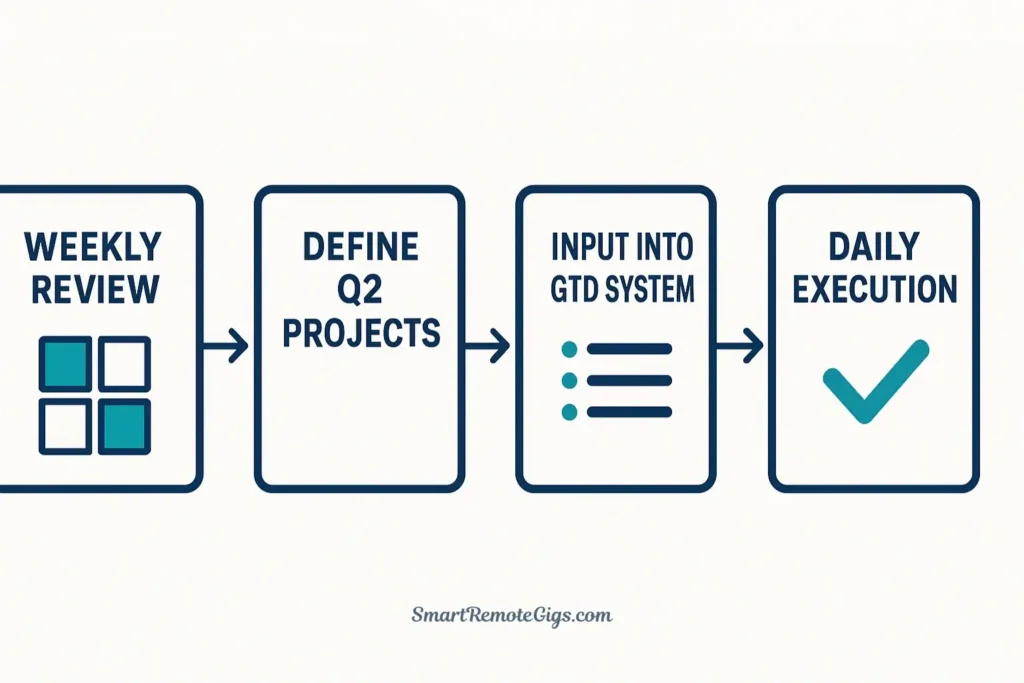
Here’s how to integrate them:
Step 1: Weekly Strategic Review with the Matrix
Start your weekly planning session by listing everything competing for your attention. Then categorize each item into the four quadrants:
- Quadrant 1: Handle these crises immediately (there shouldn’t be many if you’re doing Q2 work)
- Quadrant 2: These are your “big rocks”—the strategic projects and important work that deserve protected time
- Quadrant 3: Delegate these or set clear boundaries around them
- Quadrant 4: Ruthlessly eliminate these distractions
This gives you clarity on where your time should go this week.
Step 2: Break Down Q2 Projects Using GTD
Take your Quadrant 2 priorities—the important strategic work—and run them through the GTD process:
- Clarify: What’s the successful outcome for this project?
- Next Action: What’s the very next physical action required to move it forward?
- Organize: Put that next action in the appropriate context list (@computer, @phone, @office, etc.)
Now your big-picture priorities are broken down into concrete, actionable tasks you can execute.
Step 3: Use GTD for Daily Execution
Throughout your week, use GTD’s system to manage the day-to-day workflow:
- Capture everything that comes your way into an inbox
- Process and clarify those items regularly
- Work from your context lists based on time, energy, and priority
- Review your system daily to stay current
But when deciding what to work on, let the Eisenhower Matrix guide you: favor Q2 strategic work over Q3 interruptions.
Step 4: Weekly Review Integrates Both
During your weekly GTD review, explicitly evaluate your projects through the matrix lens:
- Are you spending time on Q2 work, or getting sucked into Q1 and Q3?
- Which projects should be eliminated (Q4)?
- What needs to be delegated (Q3)?
This integration gives you both strategic clarity (from the Matrix) and tactical reliability (from GTD). You know what matters, and you have a system to ensure it actually gets done.
The Final Verdict: Which Should You Choose?
The core difference comes down to this: the Eisenhower Matrix is for deciding what to do. GTD is for managing the doing.
Start with the Eisenhower Matrix if:
- You’re new to productivity systems and want quick wins
- Your main problem is feeling overwhelmed by competing priorities
- You’re in a leadership role requiring strategic decision-making
- You want a simple tool that works with any existing workflow
Start with GTD if:
- You’re managing complex projects with many dependencies
- You’re losing track of commitments and things are falling through the cracks
- You have the time and commitment to build a comprehensive system
- You resonate with the philosophy of complete capture and trusted systems
Use both together if:
- You want world-class productivity (this is the optimal solution)
- You need strategic clarity AND tactical reliability
- You’re willing to invest in building a robust system
- You’re serious about optimizing how you work
The best productivity system isn’t the most sophisticated one—it’s the one you’ll actually use consistently. Start with whichever solves your biggest pain point today. You can always layer in additional frameworks as your needs evolve.
If you’re still feeling overwhelmed, start with the Eisenhower Matrix this week. Categorize your tasks, protect time for Quadrant 2 work, and see how it feels. If you find yourself needing more structure to manage the details, GTD will be waiting for you.
Ready to get started? Begin with the framework that solves your biggest problem today:
- To master prioritization, dive into our Ultimate Guide to the Eisenhower Matrix and see our role-specific guides for project managers and founders.
- To build a complete workflow system, read our Getting Things Done (GTD): A Beginner’s Guide for 2025.
For the original source material, you can also visit the official Getting Things Done website by David Allen.

